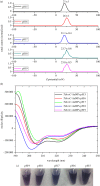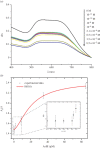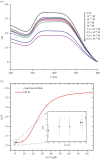Arsenate reductase from Thermus thermophilus conjugated to polyethylene glycol-stabilized gold nanospheres allow trace sensing and speciation of arsenic ions
- PMID: 27707908
- PMCID: PMC5095221
- DOI: 10.1098/rsif.2016.0629
Arsenate reductase from Thermus thermophilus conjugated to polyethylene glycol-stabilized gold nanospheres allow trace sensing and speciation of arsenic ions
Abstract
Water sources pollution by arsenic ions is a serious environmental problem all around the world. Arsenate reductase enzyme (TtArsC) from Thermus thermophilus extremophile bacterium, naturally binds arsenic ions, As(V) and As (III), in aqueous solutions. In this research, TtArsC enzyme adsorption onto hybrid polyethylene glycol-stabilized gold nanoparticles (AuNPs) was studied at different pH values as an innovative nanobiosystem for metal concentration monitoring. Characterizations were performed by UV/Vis and circular dichroism spectroscopies, TEM images and in terms of surface charge changes. The molecular interaction between arsenic ions and the TtArsC-AuNPs nanobiosystem was also monitored at all pH values considered by UV/Vis spectroscopy. Tests performed revealed high sensitivities and limits of detection equal to 10 ± 3 M-12 and 7.7 ± 0.3 M-12 for As(III) and As(V), respectively.
Keywords: arsenic pollution; enzyme; gold nanoparticles.
© 2016 The Author(s).
Figures








References
-
- Smedley PL, Kinniburgh DG. 2002. A review of the source, behaviour and distribution of arsenic in natural waters. Appl. Geochem. 17, 517–568. (10.1016/S0883-2927(02)00018-5) - DOI
-
- Moore JW, Ramamoorthy S. 2012. Heavy metals in natural waters: applied monitoring and impact assessment. Berlin, Germany: Springer Science & Business Media.
-
- Casentini B, Pettine M, Millero FJ. 2010. Release of arsenic from volcanic rocks through interactions with inorganic anions and organic ligands. Aquat. Geochem. 16, 373–393. (10.1007/s10498-010-9090-3) - DOI
MeSH terms
Substances
LinkOut - more resources
Full Text Sources
Other Literature Sources
Medical
Research Materials

